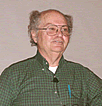| |
 |
| |
Don Burnett |
At the March 2005 annual Lunar and Planetary Science Conference in Houston, Genesis mission Principal Investigator Don Burnett announced that the mission has identified ions
of Solar origin in one of the wafer fragments. "We have solar wind," said Burnett, "and we're open for business." The Curation Facility at the NASA Johnson Space Center is now accepting science community requests from its catalogue of over 10,000 sample materials. Burnett went on to say, "The best place to have a mishap is on Earth. You can pick up the pieces. You can use every bit of modern technology to solve your problem." Although the team has had only a very early glimpse at science results, Burnett expresses confidence in long-term success.
Progress is being made on several fronts, a) the Curation Facility is now accepting science community requests from its catalogue of over 10,000 sample materials, b) contamination (both molecular and particulate) has been characterized - it has not impeded implantation of solar wind in the collectors and there are techniques that can remove the 'brown stain' and 'Dugway dirt' when necessary, c) the Genesis Advanced Analytical Instrument Facility instruments at UCLA and Argonne National Lab are now operating and undergoing fine tuning for sample analysis, d) investigators are now measuring solar abundances of magnesium and neon. Since Genesis gathered various solar-wind regimes on specific arrays, one Herculean task at hand is to determine what shards came from which plates, which can be done by thickness.The other task is to sort the different types of silicon wafers, which must be done spectroscopically.
|
|
Curation team member, Judy Allton, and JPL Project Manager, Don Sweetnam, in the contamination laboratory at JSC. |
|
"It brings a great deal of satisfaction to share with the public that our sample collectors do contain pieces of the sun, that the hard efforts and work of the Genesis Team have paid off," said Don Sweetnam, Genesis project manager at NASA's Jet Propulsion Laboratory. "I am excited for the solar scientists around the world who will now have an unprecedented opportunity to unlock the secrets of the sun." |
